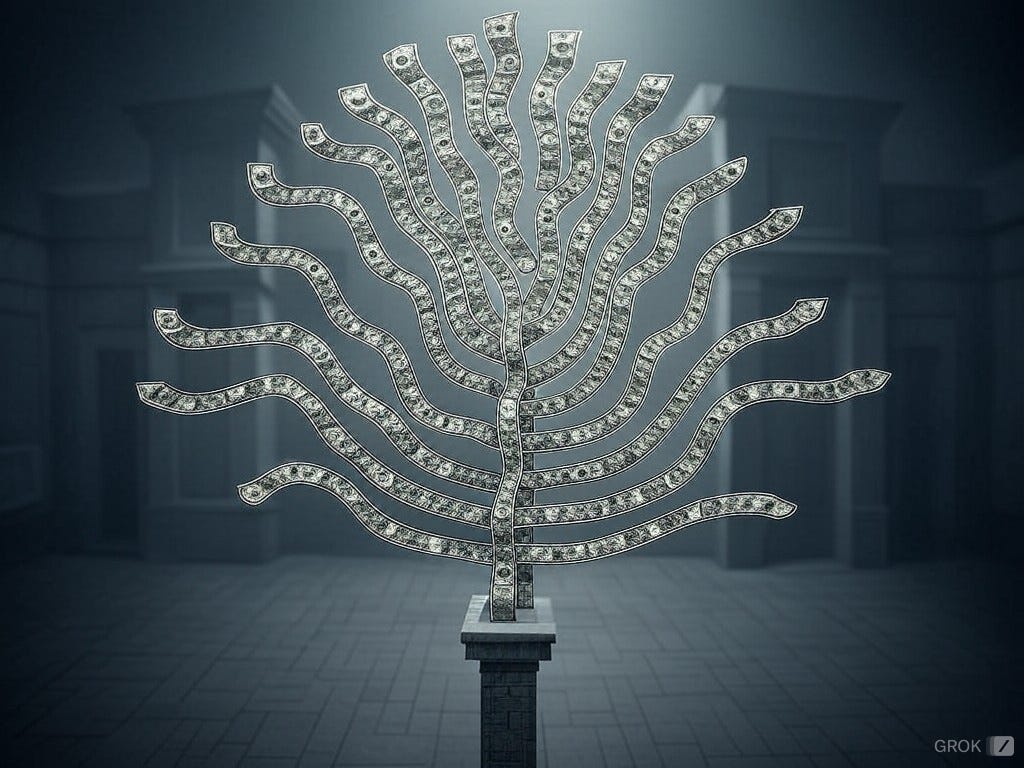A Ponzi scheme is defined as an illegitimate operation that generates no profits and earlier investors are paid hypothetical profits using capital of new investors. When investors discover that the operation generates no real profits, a new influx of funds drys up, and they demand their money back, causing a collapse.
I define the above as a strict Ponzi scheme. I also define a quasi-ponzi scheme as an operation that generates profits but investors are paid in excess of that using new investor capital. In this case, the success of the scheme depends on convincing investors that the high profitability is real and it will continue.
In the stock market, companies report earnings based on established accounting standards. If we assume that on average there is no fraud, even though that has been true in isolated cases in the past, then the earnings are real. However, in such a scheme, the growth of passive investing in the market depends on accepting that the price-to-earnings ratio (P/E) is justifiable.
There is something arbitrary with investors accepting a P/E ratio of 30, as it currently stands, as one that justifies their investment, and not, for example, a ratio of 15. In the event that a P/E ratio of 15 would be considered an upper threshold, then the S&P 500 price would have been much lower due to a lower influx of capital to buy stocks.
In a successful quasi-ponzi scheme, there are primarily three requirements:
(1) Convince investors that only passive investing is profitable and to constantly add funds despite the high valuations.
(2) Constantly invent narratives to justify the high valuations caused by the constant addition of new funds to the scheme.
(3) There will always be innovation and new profitable companies to add to stock indexes as older ones become unprofitable.
This is a self-reinforcing positive feedback loop with prices constantly rising, albeit with some volatility. Higher prices give rise to forecasts of even higher prices, which in turn cause prices to rise further. Ponzi schemes, including the quasi ones, are of reflexive nature. Large corrections occur when confidence in the stock market plummets due to unexpected events. Three recent examples are the GFC, the 2020 pandemic, and the rising inflation in 2022. The central bank intervenes in all corrections to provide liquidity while those who benefit from the scheme without taking any risks, brokers and the sell-side, rush to remind investors that over the long term prices will recover. Not even the risk of a world war makes any difference: prices will always rise if the conditions are met.
I have concisely explained to you the workings of the world's most potent quasi-ponzi scheme. This scheme can continue and justify high P/E ratios as long as the central bank and the sell-side cooperate and there is innovation. I could even claim that the P/E ratio is not even important under this powerful scheme. But caveat emptor:
The scheme can collapse under a simple persistent condition: longs - shorts < 0, i.e., when short sales increase and there is no new influx to buy stocks, and stock prices fall. Short sellers maximize their gains if the price goes to 0, and their maximum profit is 100%, while the maximum profit for longs is unlimited. Since, theoretically at least, -100% can be reached before 1000%, in the absence of any interventions, in addition to the above three conditions, the short selling rules are always adjusted and made stricter to prevent a collapse. Recently, an Asian country even banned short selling all together to prevent a stock market collapse. This can also occur in a short time in a very liquid and innovative market, as in the USA, due to an unexpected event. Although the central bank will intervene to restore confidence by providing liquidity and even purchasing assets, the loss of credibility could be detrimental and lead to a slow and painful recovery. After the 2000 top due to the dot-com bubble, it took several years for the stock market to recover, and one of the primary drivers was the increase in public debt. Long recovery periods are highly undesirable in a financial system where pensions are closely linked to stock market performance. As I have written in another article, the link of stock market performance to pensions has been the greatest accomplishment of Wall Street.
In conclusion, the US stock market can be classified as a quasi-ponzi scheme due to its high valuations, which necessitate constant "maintenance and intervention," but it is not a Ponzi scheme in the strict sense because the companies are generally highly profitable.
What about bitcoin? Is it a Ponzi scheme? According to the strict definition, bitcoin, with no significant adoption in commerce, is a Ponzi scheme. Bitcoin fulfills requirements 1 and 2 above but fails requirement 3. Specifically, HODL is the argument for passive investing, and the high valuations are justified in the context of some financial revolution. Adoption for transactions and commerce (requirement 3) will generate profits for corporations and negate the Ponzi label. If bitcoin becomes the exchange medium, then the Ponzi label will not apply, as it currently does not apply to the US dollar. At this point in time, bitcoin is mostly a Ponzi scheme due to limited adoption for transactions and especially for the fact of not being legal tender for paying taxes. The talk about a bitcoin reserve is an effort to pave the way to declaring bitcoin legal tender. However, that could create competition with the US dollar and arbitrage that can give rise to certain instabilities in the financial system that are beyond the scope of the brief article.
If you found the article interesting, please leave a comment and post the link on your social media platform of your choice. Thank you for your time and support.





Excellent thoughts thanks